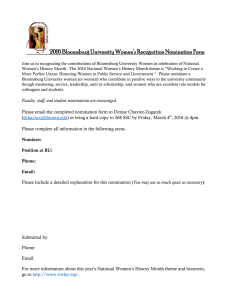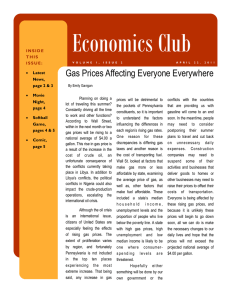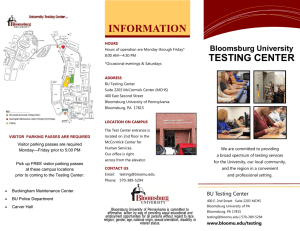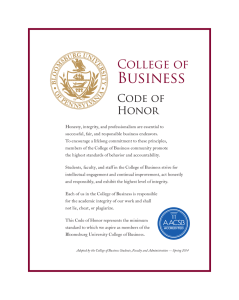Economics Dec. 9, 2011 What an Economics Journal
advertisement
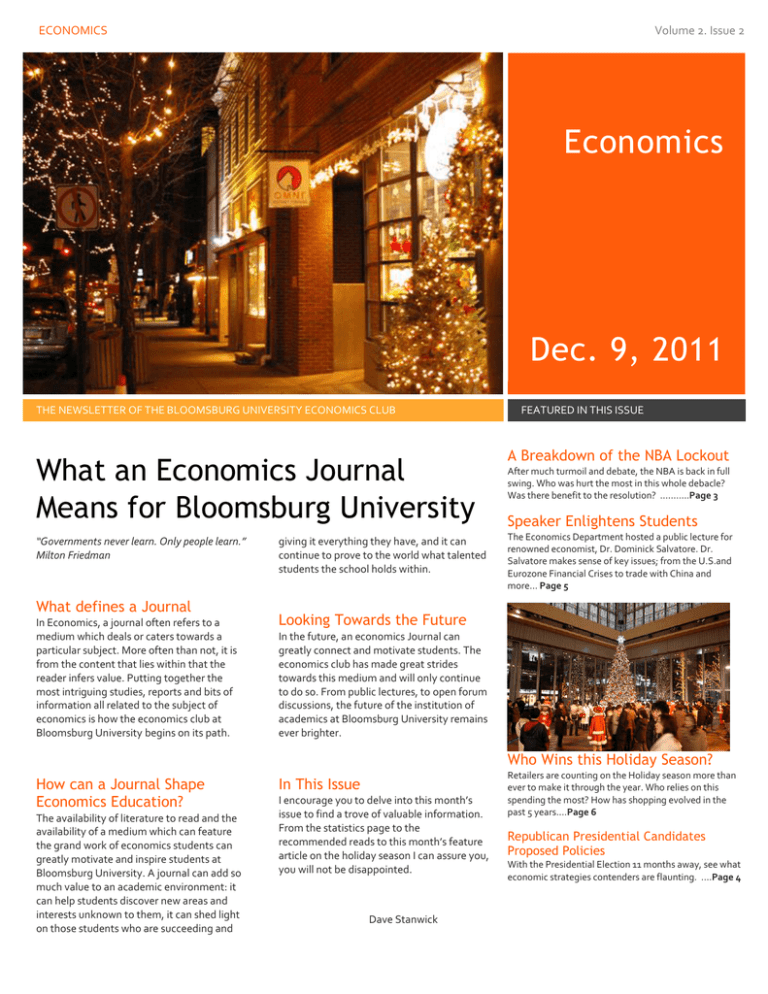
ECONOMICS Volume 2. Issue 2 Economics Dec. 9, 2011 THE NEWSLETTER OF THE BLOOMSBURG UNIVERSITY ECONOMICS CLUB What an Economics Journal Means for Bloomsburg University “Governments never learn. Only people learn.” Milton Friedman What defines a Journal In Economics, a journal often refers to a medium which deals or caters towards a particular subject. More often than not, it is from the content that lies within that the reader infers value. Putting together the most intriguing studies, reports and bits of information all related to the subject of economics is how the economics club at Bloomsburg University begins on its path. giving it everything they have, and it can continue to prove to the world what talented students the school holds within. FEATURED IN THIS ISSUE A Breakdown of the NBA Lockout After much turmoil and debate, the NBA is back in full swing. Who was hurt the most in this whole debacle? Was there benefit to the resolution? …….….Page 3 Speaker Enlightens Students The Economics Department hosted a public lecture for renowned economist, Dr. Dominick Salvatore. Dr. Salvatore makes sense of key issues; from the U.S.and Eurozone Financial Crises to trade with China and more… Page 5 Looking Towards the Future In the future, an economics Journal can greatly connect and motivate students. The economics club has made great strides towards this medium and will only continue to do so. From public lectures, to open forum discussions, the future of the institution of academics at Bloomsburg University remains ever brighter. Who Wins this Holiday Season? How can a Journal Shape Economics Education? The availability of literature to read and the availability of a medium which can feature the grand work of economics students can greatly motivate and inspire students at Bloomsburg University. A journal can add so much value to an academic environment: it can help students discover new areas and interests unknown to them, it can shed light on those students who are succeeding and In This Issue I encourage you to delve into this month’s issue to find a trove of valuable information. From the statistics page to the recommended reads to this month’s feature article on the holiday season I can assure you, you will not be disappointed. Dave Stanwick Retailers are counting on the Holiday season more than ever to make it through the year. Who relies on this spending the most? How has shopping evolved in the past 5 years….Page 6 Republican Presidential Candidates Proposed Policies With the Presidential Election 11 months away, see what economic strategies contenders are flaunting. ….Page 4 ECONOMICS | Issue 1 2 KEY STATISTICS The average US adult plans to spend $712 this holiday season. This number remains relatively stable when compared to 2010 projections. (National Retail Federation) Unemployment Rate Falls to 8.6% Dec. 2. The unemployment rate for November was 8.6%, down from 9.0% in October. 120,000 jobs were added, 11,000 less than the projected 131,000. November was the 14th consecutive month for job gains (NYtimes.com) Statistics and Economic Indicators U.S. Trade Deficit Slowly Shrinks The US trade Deficit was $43.1 Billion for September, down from a revised $44.9 Billion in August. (Census.gov) Unemployment Rate Falls to 8.6% SEASONAL ECONOMIC STATISTICS 2.8% Increase in 2011 US holiday shopping compared to the 2010 US holiday season. (National Retail Federation) $6,000,000,000 The approximate amount in sales brought in during the first week of online holiday shopping, dubbed “cyber week”. A 15% increase from 2010. (comScore Inc.) FOR MORE INFORMATION The national Retail Federation is the world’s largest trade association. http://www.nrf.com/ NRF FOUNDATION – THE RESEARCH AND EDUCATION ARM OF THE NRF http://www.nrffoundation.com/ U.S. GDP Grows 2.5% in Q3 The average hourly earnings in the US have decreased by .10% in November. This could be in part due to increased seasonal jobs at low wages. (NYTimes.com) U.S. Inflation Rate The latest US Inflation rate is 3.53%, reported on November 16th. This number is down from 3.9% reported in September. (Inflationdata.com) U.S. Non-Manufacturing Report “The NMI registered 52 percent in November, 0.9 percentage point lower than the 52.9 percent registered in October, and indicating continued growth at a slightly slower rate in the non-manufacturing sector. This is the lowest reading since January 2010, when the index registered 50.7 percent.” (Bloomberg) Economic Indicators Around the World Eurozone may be shrinking faster than Thought “The euro zone's composite purchasing managers index (PMI), while improving slightly month-on-month in November, still tallied with a 0.6 percent quarterly rate of decline for the last three months of this year. That would be worse than any forecast from more than 30 economists in a Reuters poll last month, which projected a mere 0.1 percent decline for the fourth quarter.” (Reuters) China Sees Service Sector Cool in November “The index fell to 52.5, a sharp decline given that October's reading was 54.1 -- the highest in four months -- though the index remains above the 50 level that separates expansion from contraction in the sector.” (Reuters) ECONOMICS | Issue 1 3 WALT HANDELSMAN: Economic Recovery The NBA Lockout by Emily Gavigan st On July 1 , 2011 the National Basketball Association went into a lockout: teams could not contact, trade, or sign players and players could not contact team facilities, trainers, or staff members. What is said to be dividing the players and the owners is the issues of revenue sharing and the salary cap. However, contenders say that there is no evidence supporting the idea that competitive balance is changed by salary caps and luxury taxes. This labor dispute, at heart, is a game between two teams, the owners and the players. The first team, the owners, has a substantial monopoly power as the main buyer in the market for basketball talent. The second team, the players, has a monopoly power in sale of their own talent with the sport. In an economic “battlefield” when monopsony meets monopoly the outcome is determined by bargaining, aka leverage, and means everything. The leverage sits with the owners, mainly because the money made in basketball comes at different points in time for both the owners and the players. Over the past summer, owners were willing to hold out longer for a better deal making the players nervous to reach a deal before paychecks were lost forever, and positioning the owners in a strategic bargaining advantage. On Nov. 26, the debacle came to an end with the NBA declaring the lockout over and setting games to resume on Christmas Day. Yet, contention remains. Owners are still looking to increase their personal margin of “victory” as much as possible. Owners’ teams consist of small, such as Memphis, and large market teams such as Los Angeles or New York. The small market teams who are performing financially worse than large market teams continue to ask for money. Once the small market teams become satisfied, by either the large teams or the players, the fans will get another NBA season and an era of labor peace. Until then, enjoy what we have which is a happier Christmas and the return of sport of basketball. ECONOMICS | Issue 1 4 A Look at the GOP Policies by Jarrid Dekovitch With the GOP gearing up for a large election year in 2012, we are, of course, being increasingly exposed to what the media may call “the issues,” and where the candidates stand on such issues. As you can guess, the issue we will be looking at here is… THE ECONOMY! quiet during the debate to raise the debt ceiling. Perry also supports forbidding federal spending to not exceed 18% of GDP, down from roughly 25% that it is now. Like Gingrich, Perry supports a Constitutional balanced budget amendment. Where a few of the Republican candidates currently stand on “the economy,” according to an article by the Associated Press: Newt Gingrich would like to repeal the regulations stemming from the most recent financial crisis, in addition to the regulations created in reaction to Enron and other scandals back in 2002. He would also like to reduce the powers endowed to the Federal Reserve; mainly, the ability to artificially manipulate interest rates. Gingrich also would like to add an amendment to the Constitution that compels the government to pass balanced budgets. An unbalanced budget, according to Gingrich, forces the government to raise debt limits and leads to undesired consequences. Rick Perry, similar to Gingrich, would like to repeal regulations passed after the recent financial crisis, and also repeal Obama’s healthcare bill. He is also in favor of reducing corporate taxes, however he was mostly Mitt Romney, like most, if not all, GOP candidates, proposes lowering taxes, decreasing regulation, balancing the budget, and supporting trade deals to create economic growth. He also states that certain regulations following the financial crisis should be repealed; however, he feels that changing, but not eliminating, the SarbanesOxley law would allow there to still be reasonable regulation while supporting smaller businesses. Romney stated: “We don't want to tell the world that Republicans are against all regulation. No, regulation is necessary to make a free market work. But it has to be updated and modern." He also stated that he felt the bailout of financial institutions was critical early in the recession, but did not feel the same about the bailout of auto manufacturers. Romney supports keeping federal spending as a percent of GDP at 20% or less. He was rather quiet on the debt ceiling debacle for most of the debate, however, like most GOP candidates, he also supports a Constitutional balanced budget amendment. Michele Bachmann supported $192 billion in stimulus spending but was against earlier proposed stimulus spending of nearly $900 billion. She was also against direct aid in most sectors, including housing, and would later be against financial regulations following the crisis. Bachmann stated: "Government overregulation is the single biggest jobs killer." She was also a detractor against raising the debt ceiling and various deals and proposals. Ron Paul, debatably one of the most interesting candidates when it comes to economic stances, advocates a revival of the gold standard and dissolution of the Federal Reserve, along with removing many federal regulations. He supports cutting nearly half of the federal government’s spending, and in doing so would close down five Cabinet-level agencies. Lastly, he would be in favor of ending spending on all wars and conflicts, and would decrease or eliminate foreign aid. ECONOMICS | Issue 1 5 Students Get Valuable Insight into the Global Financial Crisis RECCOMENDED READS by Dave Stanwick To illustrate, when one student asked “What does the wind-down of the Iraq war mean for the U.S. economy?” Salvatore outlined not one, but multiple points on the effect of the wind-down: the wind-down means less spending overseas and more to spend in U.S. it also means that we will have 100,000 soldiers coming home looking for employment. Further, taking into account the increase in money to spend domestically and the increase in the employment seekers, what implications will this have for the long run? How can this be turned into an advantage for the U.S. economy? How can small businesses accommodate the workforce? It was as if Salvatore had killed five birds with one stone, answering questions before they were even asked. What does the rocky economic climate mean for students now and in the future? How can world leaders turn the sails out of rough waters and into growth winds? On Thursday, Oct. 17, Dr. Dominick Salvatore, renowned economist, presented a public lecture at Bloomsburg University on “Growth or Stagnation after the Global Crisis.” The range of valuable information conveyed was astounding, with everything from background info on the financial crisis, to analysis of the Eurozone crisis, and an analysis of the current economic situation in the United States. The Economics department which hosted the public lecture helped fill every seat, packing the room in with students standing in the pack just to hear Salvatore speak. From the very moment he began, diving into who predicted the crisis and some of the key causes to the closing thoughts, Salvatore had student’s attention. A worldly person, Salvatore captivated the crowd with personal stories and explanations as to why events were occurring, everywhere from Brazil to China. The lecturer, with only an hour to present, made use of every single minute. By the time the question and answer time period came around, students were on the edge of their seats with questions. The Q&A section, where many lecturers stumble, highlighted the well-roundedness of Salvatore as he took the time to give thought out responses and provide thorough support for his reasoning’s. The Bottom Billion Paul Collier "”Rich in both analysis and recommendations...Read this book. You will learn much you do not know. It will also change the way you look at the tragedy of persistent poverty in a world of plenty."--Financial Times One drawback to the exciting event was that there was only so much time for Salvatore to go around. Had further sessions been offered, students would have leaped at the chance to spend a few moments more with a man who was a goldmine of knowledge and experience. A man who wrote the book on Microeconomics made his mark on Bloomsburg. Students who were able to make it to the lecture were provided with new insight, new perspective, and a level of knowledge that will pay dividends for a long time. Photo Credit: Alana Greene. The Voice Thinking, Fast and Slow Daniel Kahneman “Profound . . . As Copernicus removed the Earth from the centre of the universe and Darwin knocked humans off their biological perch, Mr. Kahneman has shown that we are not the paragons of reason we assume ourselves to be.” —The Economist Willpower : Rediscovering the Greatest Human Strength Roy Baumeister and John Tierney "An accessible, empirically grounded guide to willpower and how best to deploy it to overcome temptation." -Wall Street Journal ECONOMICS | Issue 1 Who wins this holiday? Bloomsburg’s Holiday Economy in Contrast to the Nation by Antonio Campanelli Many businesses wait all year for Thanksgiving to arrive, not for the food and gathering of family, but because the next day starts a trend that keeps countless businesses afloat. Black Friday received its name because it was traditionally the first day of the year that many businesses went from being, “in the red” to being, “in the black” in regard to profit. Businesses historically start to turn a profit after Black Friday because it kicks off the official holiday shopping season, where businesses can sometimes make up to 40 percent of their yearly revenue in six short hectic weeks. These six weeks are crucial to our national economy, and even right now when our economy is not thriving, holiday sales are projected to increase at least 2.8 percent. This 2.8 percent increase brings the projected spending total to an incredible $466 billion for the upcoming 2011 holiday season. Numerous businesses greatly benefit and rely on the holiday season to continue to keep their doors open, but Bloomsburg is an exception to the rule. According to comSource inc., the average US adult will spend $712 on holiday shopping this season. A growing trend that continues 6 to increase each year is online sales. Online shopping usually benefits larger businesses, businesses that would not typically be found in Bloomsburg. Small merchants, like most businesses found in Bloomsburg, have trouble competing with national giants because they lack bulk-purchasing power, deep cash revenues and other benefits that come with economies of scale. In 2005, the term “Cyber Monday” was coined after learning that online shopping increased the Monday following Thanksgiving. Big-box retailers embraced this newfound holiday and used their market share to their advantage. Year after year, online records are smashed as online holiday shopping is becoming more popular at an alarming rate. Cyber Monday has now grown into a full week of online shopping due to retailers offering big sales and free shipping the full week after Cyber Monday. This year US consumers spent nearly 6 Billion dollars over cyber week, and over 1.25 Billion on Cyber Monday alone. This was a 15 percent increase from 2010, which had increased 12 percent from 2009. Online sales are projected to increase at the same rate of 15 percent for the rest of the holiday season. According to the latest Census, the town of Bloomsburg is permanently home to approximately 15,000 people. However, Bloomsburg University is also a temporary home to over 10,000 students. This means that the addition of college students increase the population by over 60 percent during the fall and spring semesters. Students typically spend Christmas break at home, away from Bloomsburg and the businesses that rely so heavily on students for profit. While big-box retailers comprise an average of 20 percent of their sales over the holiday season, small businesses expect the holiday season to bring in upwards of 30 percent of their yearly profit. Bloomsburg is an exception to this statistic; the businesses in our college town are almost entirely small businesses, and when most small businesses use the holiday season to boost sales, many businesses in the Bloomsburg area struggle to break even. Local businesses do what they can to turn profits over the holiday season, including December sales all over Main Street, and many businesses are featured in a holiday catalog put together by the local Press Enterprise that strives to help businesses in the area. Still this is often not enough, the lack of students’ presence and the lack of online shopping available from small Bloomsburg retailers does not always mean a holly jolly Christmas for the local college town economy. While Bloomsburg businesses enjoy nice sales over the semesters, the uncertainty and unstable manner of sales can often prove it hard for local businesses to budget and stay buoyant. So the next time you’re walking down Main Street, stop into Main Street video and buy a DVD at a good price for a siblings Christmas present. Stop into Karen’s Candy Barrel and buy mom some of her favorite candy to surprise her when you return home. And grab dad a Marley’s Brewery T-shirt to support a local favorite eatery. A little local holiday shopping can go a long way to keep our local Bloomsburg favorites in business for years to come. ECONOMICS | Issue 1 Editorial Cannabis as a Start to Repairing the U.S. Economy by Nick Ragazzo The United States government is in trillions of dollars of debt, and must maximize every possible solution in order to acquire funds. The traditional ways that the government has generated currency have been at the expense of the citizens by way of taxation and cuts in government services. The most overlooked and obvious solution to this American crisis would be for the federal government to end the prohibition on cannabis. According to Nobel laureate Milton Friedman’s open letter to the President and Congress, repealing this widely ignored and antiquated law would “save $7.7 billion annually. If Cannabis were taxed similar to alcohol and tobacco, we would make an additional $6.2 billion annually”, a total of $13.9 billion dollars a year! While that is still not enough money to completely pull America out of debt, it is not a bad start to repairing the U.S. economy. There are many signs that the prohibition of Cannabis in the United States utterly fails to fulfill its expectations according to the current supply reduction policy as stated in the 2004 National Drug Control Strategy Report. The policy of Supply Reduction is intended to “make drugs more expensive, less potent, and less available”. The street value of one gram of cannabis is $20 in most parts of the nation, which makes it affordable for many Americans. The effectiveness of marijuana has actually more than doubled from 6% potency in 1993 to 13% in 2000. The government has been unsuccessfully trying to reduce the popularity of Marijuana by stepping up enforcement on users and dealers alike, in fact, about 45% of all drug arrests in America were for Marijuana. Despite these policies; the availability has not been affected, with over one million Americans reported selling cannabis annually between the ages of 13 and 17. Also the current national average age to start using Cannabis is 17, which is two years younger than it was in 1990. The reality that prohibition does not make Cannabis unaffordable, ineffective, or does anything to keep teenagers from using proves that the 7 current policy is antiquated and hinders the economy. The prohibition of Cannabis decreases the potential output of America by removing workers who are in every other aspect law abiding citizens, but have had their records tarnished by possession arrests and have been consequently denied positions they were otherwise qualified for. In 1991 there were 287,850 arrests for cannabis related offenses; the arrest rate has nearly tripled in 2009, with 858,408, of these people charged, 758,593 of them were charged with possession. Discriminating against responsible adults who choose to indulge in cannabis reduces valuable members of the workforce by almost one million! In addition, it is estimated that the opportunity cost of putting offenders in jail is over $4 billion. Instead of keeping Marijuana illegal, which only serves to fund criminal enterprises outside of the U. S., licenses should be given to legitimate and regulated businesses that would sell cannabis to responsible users of the legal age of consumption. This will stimulate the economy by creating new entrepreneurships and generating tax revenue. It would be greatly beneficial to all U.S. citizens if the current policy favoring prohibition of cannabis were retracted and replaced with a more current policy that favored regulation and taxation. Bloomsburg Students Occupy Wall Street by Gabby Vielhauer As an anthropology student, social movements are innately fascinating. The concept of thousands of people from a diverse and complex state structure like the United States assembling under a few common similarities is nothing but phenomenal. Thus, when I partnered up with a couple of socially-active students who happen to be participating in the Occupy Bloomsburg movement, we decided to embark on a trip to New York City, the origin of “Occupy Wall Street”. Including myself, there were 12 students from Bloomsburg University who attended, many of which were sociology or anthropology majors (no economics majors were present). My initial motives were objective—simply to observe the atmosphere, take copious amounts of notes, and discuss the “revolution” with those directly involved. We stayed overnight th th in the city from November 4 to the 5 and marched on the Federal Court buildings located in Foley Square from Zuccotti Park. Although brief, this ethnography educated me so much more than anything the New York Times has printed about the topic. My goal was to study the culture of this social movement. While I could write an extensive record of my findings, I will keep it short for the sake of the reader. I found a community that included men, women, youths, the elderly, the well-educated, the uneducated, unemployed, underemployed, discouraged workers, homeless, students, and most importantly the extreme and the moderate. I found that everyone interpreted the movement in a different way than the person sleeping in the tent next to them. Honestly, I believe the only common ground between the groups was that they were all passionate and optimistic about seeing change in their government. In the discussion of the country’s economic policies, there seemed to be many proposed directions. People there held conservative as well as liberal viewpoints about topics like taxes and laissez-faire capitalist structure. Some shouted for the end of capitalism, while others simply fought for economic reform or regulated capitalism. Ironically, this splintered ideology was what consolidated the group. The movement itself is actually fairly patriotic. The leaders of the movement stress that the movement is not attempting to exclude any viewpoint from their protests; rather, they are working with everyone who has a say. The protesters, often proudly claiming themselves as the 99%, just wish to be heard and respected by their government as well as the corporations. They feel taken advantage of by corporations and banks that have become so large and so powerful their voices have muted those of the public the government is supposed to be providing for. And they are angry. Sociologically, this movement is an incredible feat. What I found when I entered Zuccotti Park was almost like an intellectual militia. Once you step foot inside the park (which is now prohibited from being habitable by the police), you were immediately greeted and offered food, a ECONOMICS | Issue 1 8 Guy Fawkes masks from the graphic novel and movie V for Vendetta, symbolizing the protest against autocracy—by business or government (Ironically, the symbol is a trademark of Warner Brothers, but I digress). The police joined our march, but only to govern our path and make arrests when needed. They awaited the protestors at the steps of the New York County Courthouse. Soon enough, they started arresting people, for “obstructing pedestrian traffic”. tour, and any information you would like. They were a compartmentalized machine, which various stands assembled where one could obtain first-aid, food, books and other literature, or press-related material. They also had a large tent available for single women to sleep safely, because of reported cases of sexual assault. We also met members from Camp Anonymous, a large group whose members are active in the demonstration, who were patrolling the inside of the park to protect the fellow protesters. It was so popular that we could not find a place to stake our tents, but because the protestors have been peaceful and diplomatic throughout the entire experience, they had connections. So, with permission so long as we were gone by 8a.m., we slept of the steps of St. Peter’s Roman Catholic Church. After staking our tents, we went to the park in groups of six to talk to the people. There were talks of Thoreau (alluding to Civil Disobedience), of the sustainability of the planet, and inevitably of the disenchanted American dream by the corporate nightmare. To put it in economic terms, I believe most people feel as though the thought of these corporations are rational in this way; the well-being and prosperity of the American citizens is the marginal cost (MC) and the enormous profits are the marginal benefit (MB). Currently, the protesters believe that the corporations see MB > MC. This rationale is what they are protesting. A common misconception I believe has been made about these protesters, in fault partially by the media, is that these people are a group of unemployed, homeless bums with nothing better to do than bemoan their own failures or weaknesses (as Dr. Albahrani may see it) and blame Corporate America for being successful. This is not only inaccurate, but also insulting. Their mission statement, according to www.occupywallstreet.org, “aims to expose how the richest 1% of people is writing the rules of an unfair global economy that is foreclosing on our future.” To show their contempt and their anger, they have chosen to occupy Wall Street, literally and figuratively. They march to occupy the street, providing inconvenience to the CEO’s finishing their Starbucks on their way to work. They occupy the press with their actions so that people may be alerted and constantly reminded of their actions. And they yell and chant to occupy the minds of all the businessmen sitting in offices turning the wheels of the capitalist machine that will ultimately cripple our country. And, as a participant-observer, I marched, chanted, and placated the photographers and tourists who filmed me as I passed. The march went from Zuccotti Park to Foley Sqaure, where there are a large number of Federal and State courthouses. There were hundreds, if not thousands, of people marching. There were various signs alluding to corporate greed, the 99%, or to the reestablishment for a democracy of the people, not of big business. Protestors shouted chants such as, “Show me what democracy looks like? This is what democracy looks like” and “Hey, hey, ho, ho, corporate greed has got to go”, while members played drums, creating a rhythm that resembled a heartbeat. Many wore the I have never heard such visceral yawping in my life. The crowd went crazy, shouting vulgarities and citing the constitution as their defense. Once people started getting arrested unfairly, the congregation started chanting, “The whole world is watching”. I was documenting the uproar when I heard something heavy drop. I turned around and at that second, a police officer ran into me. It was not until after she had run off in frenzy after picking up her baton that I realized she threw it at a suspect she was chasing down. So I began to shout at the line of cops in front of us. And everyone joined in. To eliminate any bias and attempt to create a complete understanding of the situation, I went up to a police officer and very politely asked him for any comments he had about the event or how he felt about it. I was then shunned and told that I had to keep walking or I would be arrested. Apparently, in New York, standing is a punishable offence. So is walking. And sitting. Interesting, right? Finally, that night after marching back to Zucotti Park, we packed up and started back to Bloomsburg. It was an extremely enriching experience, and gave me so much more knowledge regarding ethnography than I would have ever obtained from a book or lecture. I have many stories to take away from the incredible experience and share with the public and anyone at the University. FOR MORE INFORMATION Visit www.occupywallstreet.org for continued coverage. TWITTER HASH TAGS #OWS, #OCCUPY ECONOMICS | Issue 1 9 Newsletter Staff Resources CNN mnn.com telegraph.co.uk reuters.com Bloomberg.com goodreads.com amazon.com foxnews.com tradingeconomics.com projectonstudentdebt.org finance.yahoo.com wsj.com Cover Photo Flikr User cdrichet Economics Executive Board The Newsletter of the Bloomsburg University Economics Club President: Taylor Sprenkle Vice President: Brittany Banzhoff Treasurer: Jesse Strattman Secretary: Stefanie Hendel Faculty Advisors Abdullah Albahrani Arian Moghadam The Bloomsburg University of Pennsylvania Department of Economics Do you have a project or an article you would like published? Dave Stanwick Emily Gavigan Antonio Campanelli Jarrid Dekovitch Brittany Banzhoff Phone: 570-389-4335 Fax: 570-389-4338 The Newsletter team welcomes and encourages you to submit research projects to be published. If you have any interest in seeing your work published email Emily Gavigan at: ejg34666@huskies.bloomu.edu .
